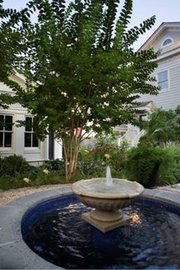Landscape designers say yards that incorporate both edible and decorative plants are popular. Herbs and patio vegetables are ideal for small outdoor areas. Photo by Marilyn Campbell
Whether creating a tapestry of bold colors, a sanctuary to escape stress or simply a low maintenance landscape, local designers say taking a backyard from dull to dazzling is easier than one might think, and offer insight into hottest landscape elements as well as trends in sustainable design.
"The biggest overall trend is that people are cocooning — that is, people are staying at home and creating multi-use spaces," said landscape architect Mark White, owner of Garden Wise in Arlington. "They want to be able to cook outdoors and have a dining area. They might want a water feature. They are creating a place for a mini-vacation in their backyard."
WATER, WATER EVERYWHERE. From custom waterfalls to simple, self-contained systems in an urn, fountains and ornamental water features are surging in popularity as homeowners strive to create a tranquil oasis in their backyards.
"Given the state of the economy and the fact that people are leading hectic lives, many are wanting calm spaces in their backyards," said White. "They are using water elements to create soothing sounds."
LET IT RAIN. Rain gardens are popular as eco-minded homeowners look for ways to decrease water pollution. Rain gardens allow rainwater runoff from surfaces like roofs, driveways and walkways to be absorbed into the ground instead of storm drains.
Landscapers at George Mason University in Fairfax, created rain gardens across campus using water-loving, native plants. The gardens help alleviate storm-water runoff and pollution.
"Also, rain gardens help to eliminate standing pools of water that might otherwise have been the perfect breeding ground for mosquitoes," said Archie Nesbitt, landscape supervisor at George Mason.
HARVESTING RAINWATER. "Many people are now collecting rainwater in rain barrels and using it to water their plants," White said. "You can connect a hose to the barrel and use it to water your garden."
HOW DOES ONE’S GARDEN GROW? Landscapes that incorporate both edible and decorative plants are popular now and serve dual purposes: providing both food and beauty. "There has been a huge interest in vegetable gardens, container gardens and fruit gardens, especially dwarf fruit trees, tomatoes, peppers and herbs," said Sherrye Schenk of Potomac Garden Center in North Potomac.
MAKING ROOM. Designers can make accommodations when space is scarce.
"Because many of the yards in this area are small, people don’t have the space to dedicate to a larger garden, so we’re putting plants in containers and growing what is known as ‘patio vegetables,’ which don't get as large," said White. "For example, there are certain varieties of tomatoes and eggplants that are suitable for a smaller space."
KEEPING BAMBI AT BAY. Homeowners who live in areas where deer abound also search for plants that don’t attract these four-legged friends.
"Anything that is deer resistant is popular now," said Alex Dencker of Behnke Nurseries in Potomac. "Nandina and cherry laurel are deer resistant. ‘Green giant arborvitae’ works if you’re looking for screen plants to create privacy. They grow tall very quickly."
GOING NATIVE. Designers say indigenous plants often grow beautifully with little maintenance and no fertilizer. "Whenever possible, allow things to be what they want to be … the more a planted area can be self-sustaining [and] not require upkeep, the better," said Nesbitt.
Drought tolerance is another bonus that makes native plants favorites among homeowners and landscape designers. "Purple cone flower are popular, as are creeping phlox which blooms early, provides great ground cover and requires little maintenance," said Dencker. "Black-eyed Susans and redbud trees are also native plants that have colorful buds. There are so many birds and other critters that need our native plants to survive. That is another reason why our native plants are so important."

